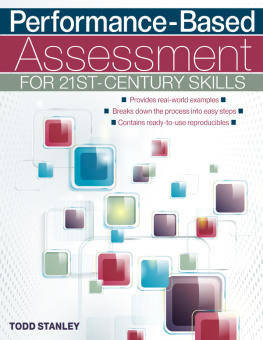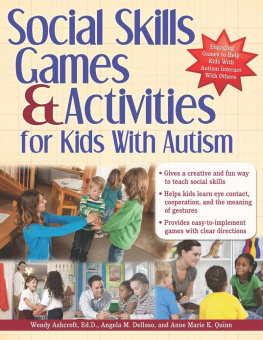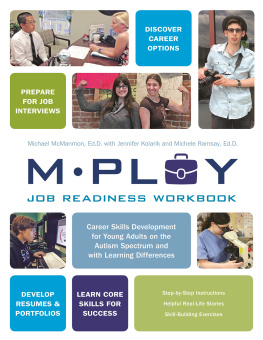TEACHING
PRE-EMPLOYMENT SKILLS
TO 1417-YEAR-OLDS
The Autism Works Now! Method
Joanne Lara and Susan Osborne
Foreword by Temple Grandin

Jessica Kingsley Publishers
London and Philadelphia
Contents
Foreword
TEMPLE GRANDIN
My sense of identity is based on my work. This is normal for lots of people. Many common surnames are also the names of occupations such as Cook, Mason, Carpenter, Smith, and Farmer. Being successful in my career has given my life purpose. I am what I do. When I was in my twenties, I wrote an article on how I made a slow transition from the world of school to the world of work. Too often students with autism spectrum disorders autism spectrum disorder (ASD) graduate from either high school or college and they have had no work experience. Work experiences should begin long before graduation. Students need to learn how to do tasks that are on a schedule. To be most effective, the tasks should be outside the immediate family. I want to emphasize it is never too late to start. If you are working with either a high school or college graduate who has not learned basic skills, he or she needs to be gradually eased away from the couch or the video games.
Mother knew how to stretch me, to try new things that were just outside my comfort zone. At age thirteen, she set up a sewing job with a freelance seamstress. Today, middle school-age children could walk dogs for the neighbors or do volunteer work at a church or community center. At age fifteen, after I had gone to a boarding school, they gave me the job of cleaning the horse stalls. I loved the responsibility of taking care of the horses. The following year I spent the summer at my aunts ranch. Mother gave me a choice; I could go for a week or stay all summer. It is important to give the child some choices and I ended up loving the ranch and staying all summer. In college, I did two internships. One was at a research lab where I ran experiments. During this summer, I had to live in a rental house with another person. The other was at a summer program for children with autism and I lived in a rented room. These internships were set up through local contacts. Throughout both college and graduate school I was doing freelance sign painting and learning more work skills.
During my career as a designer of livestock facilities, I have worked with many skilled trades people who were either dyslexic, had attention deficit hyperactivity disorder (ADHD) or were mildly autistic. They got and kept their jobs because they had both paper routes as young children and vocational training in high school. Parents need to work to get vocational skills back into the schools. Today there is a huge shortage of mechanics, welders, electricians, and plumbers. I worked with skilled trades people when they were building big Cargill and Tyson beef plants. These were big complex projects that required lots of brains to build them. My job was to design the cattle handling facilities. I have designed the front end of every Cargill beef plant in North America. A vocational career may be appropriate for about 25 percent of students with ASD or ADHD. Do not get hung up on labels. In fully verbal students, the diagnoses may switch back and forth between ASD and ADHD.
Parents and teachers must avoid the tendency to over protect and shelter students with ASD. I am seeing too many middle school and teenage students who have not learned basic skills such as shopping, because the parents always did it for them. This book has lots of advice on practical skills that students with ASD need to be taught. One basic skill that should be drilled in before graduation from high school is how to be on time. When I went to college, I had many social difficulties but being on time was not one of my problems. Once I had decided that I was going to study, I was on time. My science teacher gave me a reason to be motivated to study. Studying became important when I had the goal of becoming a scientist.
In conclusion, students must be willing to walk through the door of opportunity, when it opens. When I was asked to design the first dip vat (these are the projects that were shown in the HBO movie) I said yes because I wanted to prove that I was not stupid and that I could do it.
Sell yourself with a portfolio
I sold my design services by showing off a portfolio of drawings and photos of completed projects. The work must be neatly presented and you should always have it available on your phone or tablet. You never know where you might meet a person who can give you a job. Do not put too much stuff in your portfolio. You want a 30-second WOW when you show it to somebody. You need to target your audience. For example, do not show weird science fiction drawings when you are selling graphics to a client who has a car dealership. During interviews, I would open up my portfolio to sell freelance jobs. I learned to sell my work instead of myself. Having a career has given my life meaning. People a long time ago named their families after the names of occupations because it helped define who they were.

Preface
JOANNE LARA
Lets get out there and show people what people with autism can do!
Temple Grandin, Temple Grandin and Friends:
Autism Works Now! Event 2015 Los Angeles
Human resource interviewers should look beyond the resumes of individuals with autism and Aspergers when searching for qualified employees. With 50,000 individuals on the autism spectrum each year graduating from United States high schools with approximately an 80 percent unemployment rate, this population has proven to excel in splintered skill sets, meaning they are often good at one job. For instance, they can excel in jobs such as computer graphics, computer science, coding, analytical calculations, patterns and inconsistencies, engineering and such, all highly regarded job qualifications that are specific to many employers needs. The ASD population enthusiastically wants to work, be self-sufficient, and be contributing members of their communities.
If we begin to see job qualifications through different lenses, if we can reward individuals on the autism spectrum who have special talents in given areas, we can put to work these enthusiastic youths to work in often detailed types of jobs (in which they excel), and its a win-win for everyone. Their problem is they often cant get through an interview because of their social difficulties, so human resource interviewers need to ferret out their interests and the kinds of things they not only like to do but can do beyond most expectations.
Prior to 1975, very few people were even thinking about how students with autism could be brought into the workforce because individuals with disabilities were not allowed to be educated in the public schools in most states in the United States before that time. The truth is thatafter nineteen years of the institution of the Individual Transition Plan (ITP) being enacted as part of the Individuals with Disabilities Education Act (IDEA) 1997 (with 2004 subsequent transition revisions)only a small percentage of our youth on the autism spectrum are transitioning into jobs in their communities, even though the primary goal of the ITP was and still is to assist our students into transitioning into the workforce after high school.
The IDEA 1997 and 2004 transition revisions were both well-meaning and direct descendants from the 1975 Public Law 94-142, but the program has to be viewed skeptically at best because less than 20 percent of all graduating students on the autism spectrum have jobseven inconsequential jobs after high schooland the percentages become worse over time. Most go home and end up staying there, which is a human tragedy, anyway its viewed. Sadly, this is known as the School-to-Couch model.
Next page











